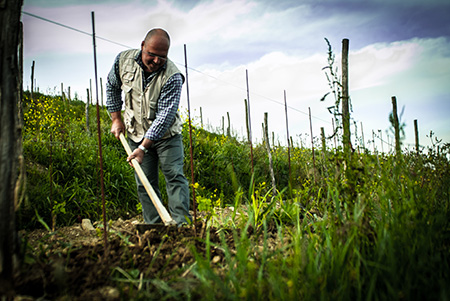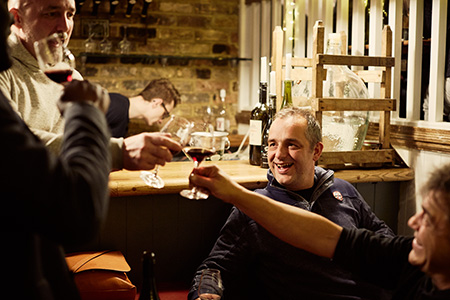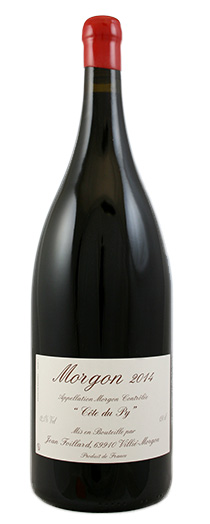Part One of The Alternative Wine Manifesto can be found here.
I wrote the manifesto below in 2008. A lot of natural wine has flowed underneath the bridge since then. It is time to re-evaluate and see how much has changed in the past 12 years. In the early days, natural wine was associated with a romantic artisan lifestyle, the small farmer who pretty well singlehandedly produced his/her own wines, went to small festivals to meet likeminded souls and sell their products. The spirit of copinage. They were simpler times. As natural wines increased in popularity and came to be viewed as a category per se, the vignerons and importers began to attract more notice, and, as a consequence, a lot of opprobrium in the press as well as criticism from other winemakers. This was for a whole host of reasons, but mainly to do with the fact that natural wine itself had become a phenomenon, synonymous with the counter-culture and appealing to a whole new generation of wine drinkers. A lot of important people felt left out, even resentful, and used their position as opinion-formers to communicate their opinions about the danger of the public succumbing to the con of these unnatural natural wines. Fast forward a few years. More growers than ever are working in an avowedly natural idiom, more importers, more wine fairs, more wine bars, more retailers. Natural wine culture is wine culture. It’s even being taught (this year, at least) on the Dip Ed. There are calls to regulate natural wine from within (groups of growers) and outside (official accreditation bodies). Much has changed in a short time.
The Revised Alternative Natural Wine Manifesto

Start from the following simple premise: to borrow from Gertrude Stein, the wine is the wine is the wine and the grower is the grower and the vintage is the vintage etc. It is not about “this is good” and “that’s better”. There is no uncritical freemasonry of natural wine aficionados and its devotees will happily diss a faulty wine if it deserves it. As in any profession there are heroes and villains. Heroes can become villains. Whomsoever is up, whomsoever is down, we treat the wine for what it is, from where it comes from and who was the person or people behind it and most of all what it says to us.
This largely still holds true, although there are some growers and certain iconic wines that who have an aura about them and apparently invite unquestioning loyalty and love for the wines. While many consumers are recognising the point where flaws tip into faults, there are some drinkers (fans) who will smell and taste no evil as far as their favourite grower is concerned. Perhaps, this reflects a propensity to look solely at the image of the grower or valuing the label as if it were a commodity rather than a wine qua wine. Perhaps, it reflects also that we are investing more in the person than the wine and, loving the one, are more able to forgive the quirks and faults in the other.
Who is the leader of the natural wine movement and articulates its philosophy?
Probably, whoever chooses to – over a drink. We are all Spartacus in our cups. Think camaraderie, copinage and comity with these guys, not po-faced table-thumping, self-indulgent tract-scribbling and meaningless sloganeering.
*The increasing number of wine fairs, forums and associated groups with charters suggests that there are people who wish to assert that natural wine is a recognised movement with specific parameters. Because of its political diversity, and because the groups and associations tend to splinter and then splinter again, it is difficult to say who is the heart or the head of such movement.
But wouldn’t it be a heck of a lot easier for consumers if there was a manifesto detailing what winemakers are supposed to do and not to do?
What conceivable difference would that make? Take several hundred individuals and ask them if they agree on every single point of viticulture and vinification. See what I mean. Rules is for fools. There are enough guidelines for natural winemakers to be getting on with and as long as they work within the spirit of minimal intervention, they may be said to be natural.
See 2. Although the original idea of natural wine was about championing diversity and prizing singularity over homogeneity and standardisation, there is an understandable desire to impose standards on vignerons to make good practice doubly assure. However, bureaucracy being made up of fallible human beings, and the element of policing and officiousness that dominates in any organisation, inevitably means growers will fall out over small matters.
But that’s cheating! How can you claim the moral high ground for natural wines if you won’t submit to scrutiny?
We’re not claiming any high ground; in fact, we prefer rootling in the earth around the vines getting our snouts grubby; we’re simply positing an alternative way of making wines that doesn’t involve chucking in loads of additives or stripping out naturally-occurring flavours. Working the land in an environmentally-sustainable has to be a (morally) positive activity. Yes, this is largely self-policed – there are no certificates to apply for or accreditation bodies to satisfy*. Praise be.
*And now there are. There is accreditation for natural winemaking from Triple A to Vin Nature, and all the charters and manifestoes issued by wine fairs across the world. There is broad agreement as to what constitutes a natural wine, but there are many small areas of disagreement. And that’s perhaps as it should be.
If natural wine is not sufficiently equipped/bothered to organise itself into a movement why should anyone take it seriously?
To paraphrase Groucho Marx: a natural winegrower wouldn’t want to belong to any club that would accept him or her as a member. The world of wine is far too clubby and cosy. In the end it is about what’s in the bottle of wine on the table. A movement is an organisation that creates rules and appoints spokespersons. Natural wine has always been more organic with people working singly or in small groups to make the best wines they possibly can.
That was indeed then. Perhaps the world was a more innocent place. The wine world is afflicted by politics and consumerist necessity. It is also driven by personalities. Some of those personalities would like to ensure that natural wine has an exclusive reputation and clearly demarcate points of difference with other wines. A natural movement with a bullet-point charter would be proof of oversight to work against the criticism from those who complain that consumers are being hoodwinked by a purposely vague designation.
But we do know who they are, these growers?
Some are certainly well known, some fly under the radar. Yes, some of them are best mates; they drop in on each other, share equipment (including horses!), go to the same parties, wear quirky t-shirts, attend small salons and slightly larger tastings. And quite a few don’t because they have so little wine to sell (such as Metras, Dard & Ribo…) By their craggy-faced visages, rough manners and horny hands shall ye know them. But their activity is not commercialised; there is no single voice that speaks authoritatively for the whole natural wine movement – and therein lies its beauty, so many characters simply getting on with the job without hype or recourse to corporate flimflam.
This point deserves re-evaluation. There may be anything between 500 – 1000 producers making what I call natural wine. It is very tricky to keep track, as many have risen without trace in the last couple of years. Caveat: To make a wine without sulphur is not itself enough to be working within the spirit of natural wine, although it is kind of start. The hard yards and miles must be done first in the vineyard. The assessment of who is making natural wine is subjective, and therefore controversial. As some producers seek to capitalise on natural wine status, we are witnessing instances of envy with unsubstantiated allegations about vineyard and winery practice, all of which arises out of personal dislike or a hidden commercial agenda.
Secondly, the importers and various wine fairs have become the voices of natural wine. There are differences of opinion and more voices means more clamour and less clarity.
A certain amount of silliness and cod-referentiality is required to appreciate natural wine.
Especially those goofy labels. Plus, a working knowledge of French argot. And probably an intimate acquaintance with the oeuvre of Jacques Brel. And #creativehashtags
#thatsevenmorethecasenow
Natural wine begins in the vines.
No, it begins in the earth. No, it begins in the place. #goethegavemethisidea
We believe that wine is a living product
… and will change from day from day and even hour to hour, just as we ourselves change.
Oak is the servant of wine not its master.
Natural winemakers understand this.
If it is a movement (and it’s not) how big could it possibly be?
We are not talking about natural wine being a drop in the ocean, but the rivers are not running with the pure stuff yet. After all, we must threaten our growers with mock violence, we get on our knees and wail piteously and bribe and cajole for our pittance of an allocation of the best stuff. Take out those Parisian cavistes and wine bar owners with their hot line to the growers, the Japanese consumers who won’t drink anything else and a healthy rump of Americans, Aussies and Italians, and there’s barely enough to whet your appetites and wet our whistles, let alone begin to satisfy the market we’re priming over here. Small is beautiful and marginal is desirable, as long as continuity is not a commercial issue. We gnash our teeth, but we love it as the knowledge that the wine is such a finite commodity makes it all the more precious (my precious) and we become ever more determined that it goes to an appreciative home.
This is a question I am repeatedly asked. Is natural wine a niche thing, a figurative and literal drop in the wine ocean, or does it have the potential to be more. I dispute that the wines are niche and not commercial; this is more to do with what successive generations of wine drinkers wish to consume. Since the time when we first identified this as a style of wine that we were comfortable calling “natural”, the market, if we can characterise it thus, has expanded enormously to embrace the wines. From one bar, a tiny handful of importers and one wine fair to bars, restaurants, several fairs, to many dozens of retailers and importers. In the UK alone. And many many more farmers and producers. However, they are not part of a single movement.
99% of people who criticise natural wine have never made a bottle of wine in their lives.
110% of statistics like this are invented.
The heroes of the natural wine movement are the growers.
There are mentors and pupils, there are acolytes and fans, but no top dog, no blessed hierarchy, no panjandrum of cool albeit some are born cool and some have coolness thrust upon them. Some growers are blessed with magical terroir; others fight the dirt and the climate, clawing that terroir magic from the bony vines. They are both artisans and artists. What impresses us about the best natural growers is their humility before nature and their congeniality, a far cry from the arrogance of those who are constantly being told their wines are wonderful a hundred times over and end up dwelling in a moated grange of self-approval.
When the history of natural wine is written (or written again) there will be some stand-out personalities. The narrative, rather than being fluid and inevitable, meanders and lurches. Without Chauvet and Lapierre and the BD guys in the Loire and some of the Triple A growers in Italy, perhaps natural wine would have taken even longer to cause ripples. And you have to give enormous credit to the very few writers and commentators who put their heads above the parapet and championed this breed of vigneron.

One new world grower said to me that he felt had more in common with vignerons several thousand miles away
He understood their language, loved drinking their wines – these people were his real family.
Natural wines – they all taste the same, don’t they?
D’oh! Of course they do, there isn’t a scintilla of difference between these bacterially-infected wines which are all made to an identical formula of undrinkability; they are totally without nuance, subtlety, complexity, and those who drink, enjoy and appreciate natural wines evidently had their taste buds removed at a very young age with sandpaper. This canard is one dead duck.
It is still a cliché bandied about by sceptics of the style, that all natural wines taste like… cider or barnyard… or vinegar. This suggests that critics are intoxicated by generalisation.
Doesn’t the process of natural winemaking mask terroir?
Terroir is in the mouth of the beholder, perhaps, but the clarity, freshness and linear quality of natural wines, supported by acidity, makes them excellent vehicles for terroir expression. But bad wine-making, be it in the conventional or natural idiom, always masks terroir. In the final mix, if the wine has a distinctive accent that is not obscured by process, then something of that precious terroir signature has been preserved.
Within the spectrum of natural wines, there are styles that are much more about instant gratification than the expression of terroir. These are known as glouglou or soif wines, usually the result of carbonic maceration and short elevage. Some might say that the process of skin contact in making orange wines inhibits terroir character. This is nonsense, and the opposite is more likely to be the case. Nor does oxidative winemaking obscure terroir; it just shows it in a different context.
Natural wines are incapable of greatness.
Let us put aside for a moment the notion that good taste is subjective and transport ourselves to our favourite desert island with our dog-eared copy of the Carnet de Vigne Omnivore, the natural wine mini-bible. Because the natural wine church has many mansions; you will discover a constellation of stars lurking in its firmament. Natural wine growers don’t work according precise calibrations of sulphur levels; instead they seek to express the quality of the grapes from their naturally farmed vineyard by keeping interventions to a bare minimum. In certain regions such as Beaujolais, Jura and the Languedoc-Roussillon, virtually all the great names are what we might term “natural growers”. Again, we don’t seek to make anyone join the family or fit in with an overarching critique. Natural wine is fluid, in that vignerons who are extremists, row back from their position, whilst others, who start out conventionally, feel emboldened to take greater risks by reducing the interventions.
Since writing this I have decided that greatness is purely an illusion. What many people have traditionally called great are wines that are seemingly “architectural”, constructed to such a level that you can see all the layers attaching to each other. For me, greatness is far more elusive, tantalising – and personal. Wines that have this quality throb with energy, they open and close and open again, they resist tasting notes, they inspire – initially neither like nor dislike – but feeling, and activate all the senses to their most responsive.
Natural wines don’t age well.
Hit or myth? Myth! It is true that many natural (red) wines are intended to be drunk in the first flush of fruit preferably from the fridge. So, sue them for being generous and gouleyant. Ironically, many white wines with skin contact and deliberate oxidation have greater longevity and bone structure than red wines. But it is simply not true to assert that natural wines can’t age. A 1997 Hermitage from Dard et Ribo was staggeringly profound (et in Parkadia ego), old magnums of Foillard’s Morgon Côte du Py become like Grand Cru Burgundy as they morgonner, some of Breton’s Bourgueils demand that you tarry ten years before becoming to grips with their grippiness. Last year we tasted a venerable 10.5% Gamay d’Auvergne from Stéphane Majeune, as thin as a pin, and still as fresh as a playful slap with a nettle, whereas the conventional big-named Burgs, Bordeaux and Spanish whatnots alongside it all collapsed under the weight of expectation and new oak. If the definition of an ageworthy wine is that you can still taste the knackered lacquer twenty years after, then give me the impertinence of youth any day.
The health of the wine lies in the bone structure and not in the flesh (which will wither). Some natural wines have amazing purity and minerality (that word), a structure built on the most solid foundations (great farming, great grapes) and sensitive winemaking (long elevage, the best kind of flavour extraction).

Natural wines are unpredictable.
You said it, kiddo. And three cheers for that. Their sheer perversity is embodied in these lines by Gerard Manley Hopkins:
And all things counter, original, spare, strange;
Whatever is fickle, freckled (who knows how?)
With swift, slow; sweet, sour; adazzle, dim…
My glass is empty.
As it should be – it was a glass of delicious Crozes-Hermitage Rouge from Dard & Ribo.
**
shop@lescaves.co.uk | sales@lescaves.co.uk | 01483 538820
*Note: We are still open for business, doing deliveries, and keen to help everyone with their booze needs in this difficult time. Natural wine lovers can visit our online shop and order online!

